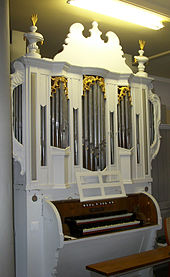Rädel (Lehnin Monastery)
Rädel was an independent municipality in the Lehnin office until April 1, 2002 and has since been part of the municipality of Kloster Lehnin in the Potsdam-Mittelmark district of the state of Brandenburg .
location

Rädel is located 30 kilometers southwest of Potsdam in forest and water-rich surroundings in the Zauche landscape . Large parts of the surrounding forest have been used as the Lehnin military training area since 1956 .
history
When the second Brandenburg Margrave Otto I founded the Lehnin monastery in April 1180 , Rädel, as Radele, was one of the five villages that originally provided this Cistercian monastery . This can be found in the confirmation document of Margrave Otto II about the donations from his father to the Lehnin monastery from 1190 (first documentary mention of Rädel). According to Charles IV's land register from 1375, the monastery village of Rädel, as Redel, had 41 hooves , of which 4 hooves belonged to the pastor and 37 hooves belonged to the farmers, who had to pay rent, interest and compensation . The monastery paid interest for 11 kossaets and a jar. After the death of Abbot Valentin, the Lehnin monastery was dissolved in 1542 and converted into an electoral domain office. Rädel then belonged to the Lehnin domain office .
The church's visitation registers from 1541 describe Rädel, (as Redel ), as the mother church of Schwina (since the 1930s Emstal), Damelang and Lehnin. During the Thirty Years' War , Rädel was attacked and sacked by Wallenstein troops in 1626. Many Rädeler residents and the pastor of the village were shot. At the beginning of the 18th century, the recovery from the war damage was noticeable. Small trades such as blacksmiths, linen weavers and brewers are listed in Rädel's church register. A tar hut had been in operation since the end of the 17th century and the first brick barn was built in 1736. In 1739 the Rädeler Church was rebuilt with a roof tower on the east side. From 1717 the sexton also worked as a schoolmaster.
The village name Rädel can be found for the first time in 1775 in the topography of the Mark Brandenburg by Anton Friedrich Büsching . In the church book of Rädel the spelling "Redel" was used for the village name until 1781. Between 1776 and 1778, Friedrich II established a settlement with three settlers near Rädel. At the beginning of the 19th century, the old school and sexton's house was too small for the sharp increase in the number of students. The former head forester's house in Rädel was converted into a school and handed over in 1832.
In the following years, with the increasing brick production, the population increased significantly. The first ring kiln was built in 1867 and in 1893 a horse-drawn tram was laid to Lehnin to transport the bricks . In 1905 a second brick factory was built. In 1913 there were 10 ship owners in Rädel who took over the transport of bricks from Lehnin to Berlin. Around 1900 Rädel had 650 inhabitants. Due to the increased construction activity, the former street village received its current horseshoe-like village shape. In 1912/13 the Rädeler Church was rebuilt. The roof tower was torn down and a massive tower with a gallery staircase and bar chamber was added on the east side of the church. The church received its neo-baroque appearance and has been a listed building since 1984. In 1950 the brickworks in Rädel were expropriated according to the court ruling and converted into a state-owned company that produced until 1963. The former brick site was subsequently used by the local agricultural production cooperative. The Hans Rosenthal Foundation has been running a child and youth welfare facility here since 1997.
Political Affiliation
- 1180–1542 Lehnin Monastery
- 1542–1807 electoral and later royal domain office Lehnin in the district of Zauche
- 1815 Zauch-Belzig district
- 1952 Brandenburg Land district
- 1993 Lehnin office in the Potsdam-Mittelmark district
- 2002 part of the municipality of Kloster Lehnin
Culture and sights
Rädel nature village
Rädel is located in a forest and water-rich landscape and bears the title "Nature Village". The Emster rises from Rädel . Broad-leaved marsh orchid blooms near the village in May . It is one of the largest orchid occurrences in the state of Brandenburg. Signposted hiking trails lead through the Lehniner Mittelheide nature reserve and the source area of the Emster . At the Gohlitzsee there is a natural swimming area with a jetty. The scarecrow festival on the first Sunday in July is the annual highlight of village life.
church
Listed baroque building from the 18th century with a tower on the east gable.
literature
- Marianne Hadan: Chronicle of the village of Rädel . 1190 to 2009. Ed .: Heimatverein Naturdorf Rädel e. V. Lehnin Monastery, 2009.
- Stephan Warnatsch: History of the Lehnin Monastery 1180–1542. Studies on the history, art and culture of the Cistercians. Vol. 12.1. Freie Universität Berlin, Diss. 1999. Lukas, Berlin 2000. ISBN 3-931836-45-2 , p. 52.
Web links
- Rädel in the RBB program Landschleicher on February 18, 2018
Individual evidence
- ^ Adolph Friedrich Riedel : Codex diplomaticus Brandenburgensis , Berlin 1838–1869, Volume AX, pp. 182/183.
- ↑ Johannes Schultze: Das Landbuch der Mark Brandenburg 1375 , Berlin 1940, p. 216.
- ^ Adolph Friedrich Riedel: Codex Diplomaticus Brandenburgensis , Berlin 1838–1869, Volume AX, p. 391/392.
- ^ Peter Rohrlach: Historisches Ortslexikon für Brandenburg , Weimar 1977, pp. 341–343.
- ^ Anton Friedrich Büsching: Complete Topography of the Mark Brandenburg , Berlin 1775.


